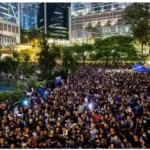Seoul’s extensive subway system is embarking on a bold initiative to combat rush-hour congestion by introducing seatless carriages on select trains. The operator has unveiled plans for a trial program commencing in January, during which seats will be removed from two carriages on subway trains traversing two of the South Korean capital’s nine major lines during the morning and evening peak periods. This innovative approach is part of a broader effort to alleviate congestion within one of the world’s most bustling metro networks.
Seoul Metro reported that by the third quarter of 2023, Lines 4 and 7, where the trial will be implemented, had experienced congestion levels of 193.4% and 164.2% of capacity, respectively, during peak hours. The removal of seats is expected to reduce peak congestion to 153.4% on Line 4 and 130.1% on Line 7 per subway carriage.
Seoul Metro manages one of the planet’s most extensive urban railway networks, encompassing nine lines and 275 stations, catering to an estimated 7 million daily commuters.
Seoul Metro’s CEO, Baek Ho, expressed the intention to expand the initiative if the pilot project proves successful, with the aim of providing citizens with a more comfortable and secure subway experience.
In addition to this innovative seating adjustment, Seoul Metro has taken immediate steps to alleviate overcrowding on these two congested lines by increasing the number of subway trains during rush hours, effective from Monday.
Local media have begun to speculate whether this initiative might finally offer relief to the daily frustrations experienced by commuters on overcrowded subway trains, often referred to as “jiokcheol,” a term combining “hell” and “subway.”







